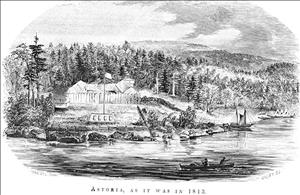In 1812, the Pacific Fur Company of John Jacob Astor (1763-1848), a New York merchant active in the fur trade with China, establishes a trading post called Fort Spokane near the current site of the city of Spokane in Eastern Washington. Astor’s American company builds its post where the Little Spokane River joins the Spokane River, next door to Spokane House, a post established two years earlier by Astor’s Canadian rival, the North West Company. After two years of trade rivalry, Astor’s representatives sell all his Northwest posts to the North West Company, and Fort Spokane merges with Spokane House.
Astor’s Pacific Fur Company was in a race with the North West Company to reach the Columbia River and stake a claim to the fur trade in the region. The North West Company, based in eastern Canada, had gradually expanded over the Rocky Mountains, establishing trading posts in present-day British Columbia, Montana, and Idaho. By 1810, Jaques Raphael "Jaco" Finlay (1768-1828) and Finan McDonald of the North West Company had set up Spokane House, which is significant as the first longterm non-Indian settlement in what is now Washington state.
The Astorians
Meanwhile, Astor, who was born in Germany and arrived in New York as a penniless immigrant, had made a fortune in the fur trade with China. By 1810 he decided to expand his operations from the Great Lakes region to the rich fur territory of the Northwest, and incorporated the Pacific Fur Company to do so. Astor held the majority of stock, and the rest was distributed among partners including Wilson Price Hunt, Duncan McDougal, Donald McKenzie, John Clarke, and others. Except for Astor and Hunt, most of the partners were Canadians who had previously worked for the North West Company.
On September 8, 1810, the first Astorians, as the Pacific Fur Company men were known, sailed from New York in the ship Tonquin, which reached the Columbia in the spring of 1811. The partners on board selected a point on the south bank of the river and built a post they called Astoria, where the modern Oregon city of the same name is now located. Meanwhile, a second party, under Hunt, left St. Louis in March 1811, and reached Astoria a year later after a particularly grueling overland journey.
Fort Spokane
A few months later, on May 10, 1812, partner John Clarke arrived at Astoria with additional men and supplies in the ship Beaver. Soon thereafter, Clarke was sent with 32 men to establish a post on the Spokane River to compete with the North West Company’s Spokane House. It was not uncommon for competing trading companies to set up next door to each other. In Canada, North West Company and Hudson’s Bay Company outposts were often found side by side. The traders realized they were competing for the same furs regardless of their physical proximity, and they were often social friends, even if business rivals, who welcomed the companionship. Like its Canadian counterpart, Fort Spokane consisted of a number of buildings within a stockade; the American post even boasted a dance hall.
The competition between the Pacific Fur Company and the North West Company lasted for only two years until the War of 1812 brought it to an end. When the Astorians learned, in January 1813, that the United States and Great Britain were at war, they realized they were in a precarious position, since the British Royal Navy controlled the sea. Not only could it cut off the route around the Horn that they depended on for supplies, but also a British ship could arrive at any time and forcibly seize Astoria and all their property.
The Astorians Sell
For these reasons, and perhaps as some have argued because most of the partners on the scene were from Canada (still a British colony) and former employees of the North West Company, the Astorians were receptive when a delegation from the North West Company arrived at Astoria and offered to buy out the Pacific Fur Company holdings before they were seized. The American partner, Hunt, opposed the plan but could not prevent it. On October 16, 1813, Astorian partners including Clarke, who had opened Fort Spokane, signed an agreement selling all the Astorian holdings in the Northwest to the North West Company for about $58,000. The sale marked the end of Fort Spokane, which was merged into Spokane House.
The controversial sale had ironic implications for both sides. When a British warship arrived at Astoria just after the sale, the captain was disgusted to find he had nothing to capture, since the Canadians were in occupation. On the other hand, when the war ended in 1814 with the Treaty of Ghent, which provided for return of all captured property, Astor did not get Fort Spokane or his other posts back, because they had not been captured but sold. As a result, the fur trade on the Spokane River and throughout the Pacific Northwest remained in Canadian and British hands for many more years, until after the boundary was finally resolved in 1846.

